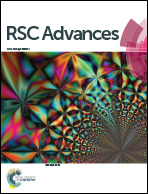A simple quantitative estimate of the number of functional groups on the surfaces of single-walled carbon nanotubes†
Abstract
We develop a quantitative analytical method to estimate the number of functional groups on single-walled carbon nanotube (SWNT) surfaces by simply measuring the Raman features of functionalized SWNTs. We use diazonium chemistry to attach functional groups to the SWNT surfaces and calculate the number of functional groups on the SWNTs by measuring their densities and using the analytical method developed in this study. We successfully establish a linear relationship between the independently estimated number of functional groups per carbon atom and the area ratio of the disorder mode (D peak, 1289 cm−1) to the tangential mode (G peak, 1582 cm−1) from the Raman measurements. From this study, we find that the injected reagents do not completely react with SWNT after 0.0263 functional groups per carbon atom are already attached to SWNT surfaces, e.g., 2.354 functional groups per nm (6, 5) of SWNT, therefore above this range, there is no linear relationship between the number of functional groups on SWNTs estimated from injected reagent concentration and the D to G area ratio (AD/G) of the Raman features. However, the number of functional groups per carbon atom (nf) estimated using the analytical method developed in this study linearly depends on the area ratio of D to G peaks of the Raman spectrum even above this range (nf = 0.02AD/G), therefore this simple and quick estimation scheme can provide an analytical basis for a variety of SWNT applications. We take into account the decrease of the number of surfactants by the coverage of functional groups on SWNTs in this scheme, and also verified that this relation is valid irrespective of SWNT diameter distributions.


 Please wait while we load your content...
Please wait while we load your content...